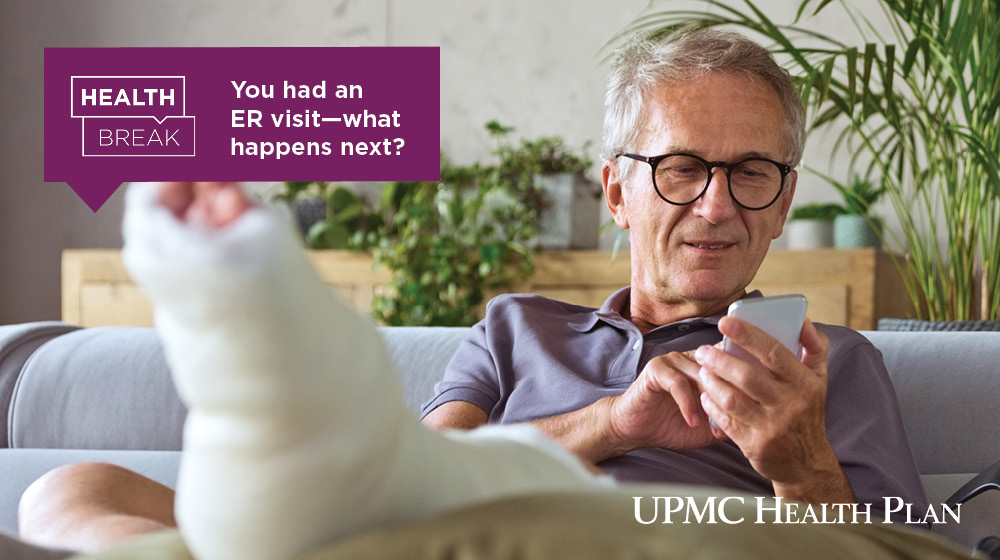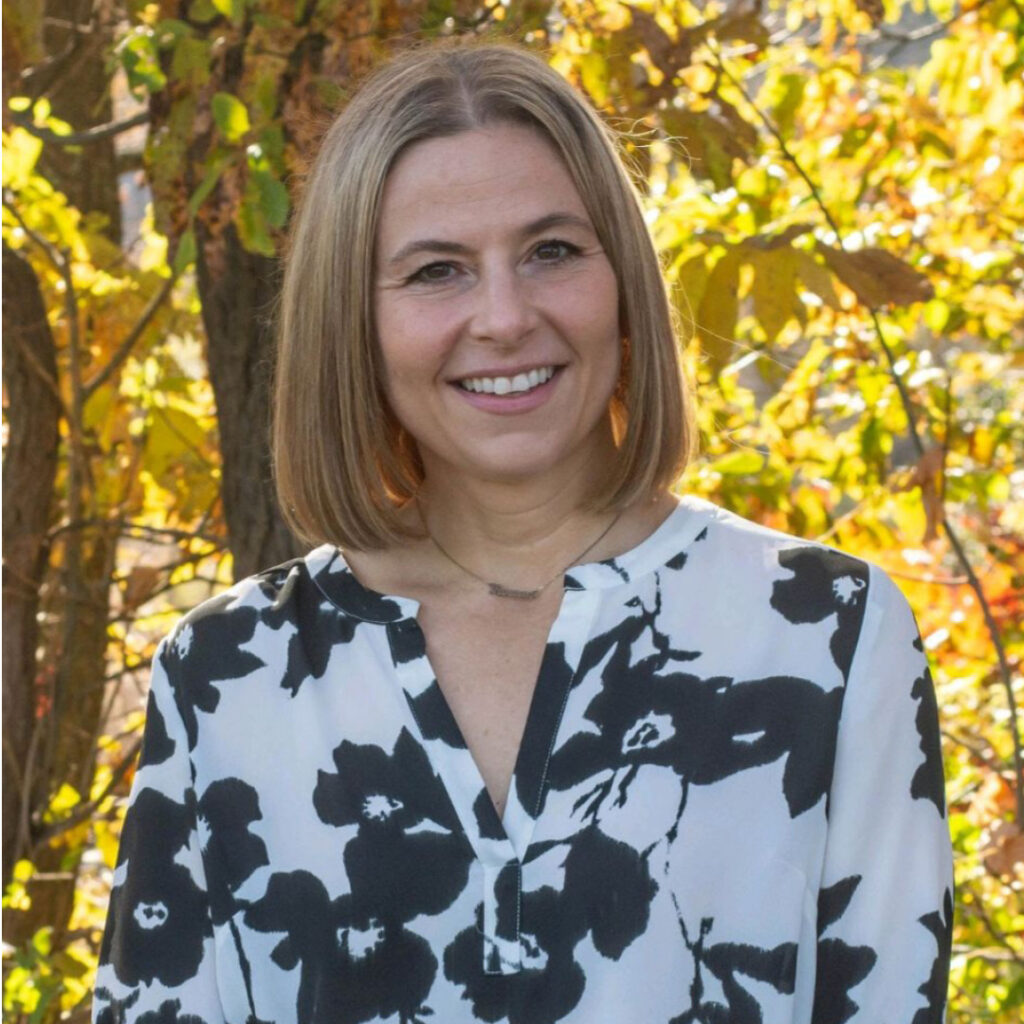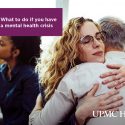Health Break: You had an ER visit—what happens next?

A podcast for UPMC Health Plan members, Health Break is your quick guide to caring for your mental and physical health, prioritizing wellness, and making the most of your health insurance plan.
Episode 40: Take a Health Break with Rebecca Ballentine
Rebecca Ballentine takes a Health Break to review the next steps you should take after an ER visit.
Episode transcript:
Camille: Welcome to Health Break by UPMC Health Plan, your quick guide to health, wellness, and how to make the most of your health insurance plan. I’m your host, Dr. Camille Clarke-Smith. I help to oversee the quality of the plans and programs we offer at UPMC Health Plan.
Angelo: And I’m your co-host, Angelo Bartic. I’m a health coach who works with our members on making healthy lifestyle habits and setting goals. This is your…Health Break.
Today we’re learning about the important next steps to take after an ER visit. And here to discuss them with us is Rebecca Ballentine. Rebecca, thank you so much for spending some time with us today.
Rebecca: Thank you for having me. Happy to be here.
Angelo: So we know that when someone goes to the emergency room, it’s usually because of an emergency, and things happen quickly and can be overwhelming. What’s one of the first steps someone should take after they are discharged from the ER?
Rebecca: Well, I think we all can imagine that when you go to an ER, you’ve had something that was an emergency and something you didn’t expect. So there’s sort of this time after you leave that you’ve experienced this whole thing and now you’re at home and you say, “Now what?” And if you, what you want to be able to get yourself to the place to feel once you’re at home is that you know what the “now what?” is. That you feel like, okay, I know what to do, this has happened to me, I’m settling back at home, and I feel like I have the tools to help myself get through this. And I think some of those tools, first and foremost, are prescriptions and taking your whole prescription. Are you able to pick them up? If you don’t have mobility or support to pick them up, what options do you have for that? Also, do you have the supplies you need to take care of your wounds? Do you have the equipment within your house to be able to manage your daily activities if some of that has been affected by whatever’s going on with you? And so if you don’t have any of those things or you’re feeling at home and you’re saying, gosh, I don’t know if I can manage this myself, talk to your primary care physician, reach out to them, reach out to your specialist. But also if none of those things are available as fast as you need, use the number on the back of your member ID card and that will connect you with Member Services who can then connect you with all the services that can help you, including, you know, depending on where you live and what your plan is, food if you need it, transportation, making sure that you have the prescriptions that you need at the right time.
The other thing you want to make sure that you do is, within a day or two, again when things settle down, make an appointment with your PCP (your primary care physician) or a specialist. If you have a cardiologist, a neurologist, a pulmonary specialist, make sure you follow up with them. And the best thing would be to try and get that appointment within the first seven days after leaving the ER. That can really help to make sure that you don’t have another ER visit in the future, or that you don’t end up inpatient or have an exacerbation of what had just happened. One of the best ways to predict who will be in the ER in the future are those people who have recently visited the ER. And so having a recent ER visit just puts you at risk for having that sort of incident again.
Angelo: Why is it important to avoid having another trip to the ER?
Rebecca: Well, as overwhelming as it is to go to the ER the first time, I think it’s pretty devastating to be like, oh, here I am back again. And the best way to prevent that is to start noticing symptoms or thinking about symptoms that led up to your last emergency department visit. If you felt a certain way a day before, but you thought, I’ll maybe wait, and it escalated, think about those symptoms. And you can talk with a provider, you can talk with someone at the Health Plan, you can figure it out with you and your family alone: What can I do when I have this symptom? It’s called the symptom response plan. For example, if my breathing is a little bit labored, I use this medication, that’s what my doctor, you know… Make these symptom response plans with your health providers and make sure your family knows them too. If I’m feeling a little more out of breath, I’m gonna call the primary care physician and see if they can see me today. And make sure that based on severity, you know exactly what you can do that can prevent the exacerbation to the point where then you have to go to the ER again.
Angelo: So would you mind speaking a little bit about some of the resources that are available to help during that time?
Rebecca: Yes. One big one is UPMC AnywhereCare. That is an app where you can have a video visit with a provider that you can do right from your home on your couch from your phone. And I should mention that there’s [a] UPMC Children’s AnywhereCare option within that as well. Also e-dermatology is something that you can do from your phone that you won’t be doing a video visit right away, but you can put your symptoms in, send pictures, and get response.
Additionally, if you live in Allegheny County your doctor can refer you to In Home Urgent Care, where they can come to your house and do basically an ER visit on your couch. And so that’s a really nice resource for people that don’t want to have to travel back and go in. Also, for those people who have COPD or heart failure, there is a program called Connected Care where you can have monitoring from your phone at home with connection to nurses that will follow you for a number of days after an ED visit. And your doctor can connect you with those as well.
Angelo: Thank you, Rebecca, for those great resources. We’ll make sure to include the links in our show notes. Thank you so much for taking a Health Break with us and discussing the important next steps to take after an ER visit.
Rebecca: Thanks for having me.
Angelo: Keep this information in mind for when you think you might need to go to the ER or after an ER visit.
Find show notes and more information at upmchealthplan.com/podcast. Join us as we continue exploring health, wellness, and how to make the most of your health insurance plan in the next episode of Health Break.
This podcast is for informational and educational purposes. It is not medical care or advice. Individuals in need of medical care should consult their personal care provider. Views and opinions expressed by the hosts and guests are solely their own and do not necessarily reflect those of UPMC Health Plan and its employees.
Related to this episode:
About Rebecca Ballentine:
Rebecca Ballentine has a master of arts degree in exercise physiology and two bachelor of science degrees, one in biomedical science and one in psychology. She is an American College of Sports Medicine (ACSM) Registered Clinical Exercise Physiologist. Her 25-year career has been primarily in medically based health and corporate wellness operations leadership with five years spent teaching and managing R1 research at Case Western Reserve University. In 2015 she joined the UPMC Insurance Service Division family as a manager in Workpartners responsible for facilitation of clinical product integration assuring the right services offered at the right time. This role evolved to include broader operational capacity monitoring the effectiveness of process flow, implementing workflow to improve efficiency, and guaranteeing quality of service. At the beginning of 2020 Rebecca had the pleasure of joining the Clinical Affairs team with management of transition coordinators, Partners in Care, and Clinical Decision Support.
*Members who are in Pennsylvania at the time of a virtual visit may select a UPMC-employed provider, subject to availability and discretion of the provider. Members located outside of Pennsylvania at the time of service or those who select Talk Therapy or Psychiatry services will receive care from a provider employed or contracted by Online Care Network II PC (OCN), also known as Amwell Medical Group. It is at the discretion of OCN providers to choose whether to treat patients ages 0 to 2. OCN is not an affiliate of UPMC. Limitations may apply for members of ASO plans who have opted out of coverage. Talk Therapy or Psychiatry services through AnywhereCare are not covered services for UPMC Community HealthChoices participants, UPMC for You members, or UPMC for Kids members. UPMC Children’s AnywhereCare is not available outside of Pennsylvania. If a member is under the age of 18, the member’s parent or legal guardian must be with the member during the video portion of the visit, and the child and parent or legal guardian must be in Pennsylvania during the visit. Providers are not available to treat members who are in Puerto Rico.




